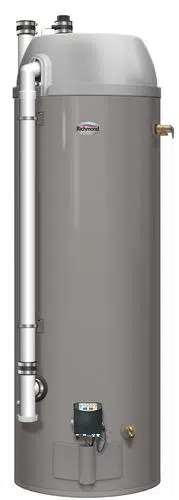Loading ...
Loading ...
Loading ...

15
DO NOT install the vent terminal under any patio or deck.
To help prevent moisture from freezing on walls and under
eaves, do not locate the vent terminal on the side of a
building with prevailing winter winds.
When terminating the vent and combustion air-inlet pipes
through brick or masonry surfaces, the installation of a rust
resistant sheet metal backing plates behind the vent and
combustion air-inlet terminals are recommended.
DO NOT locate the vent terminal too close to shrubbery, as
flue gasses may damage them.
Caulk all cracks, seams and joints within 6 ft. of the vent
and combustion air-inlet terminals.
In cold climates, precautions may need to be taken to ensure
that the condensate in the vent pipe does not freeze.
Support horizontal sections of the vent and combustion
air-inlet pipe every 4 ft. DO NOT rigidly secure the vent
system. Provisions must be made to allow for expansion
and contraction of the vent system.
DO NOT install the vent and combustion air-inlet terminals
less than 1 ft. above grade or above average snowfall
whichever is greater.
Permanently seal annular openings around the vent and
combustion air-inlet system penetrations using approved
materials to prevent entry of combustion products into the
building.
WARNING: Moisture in the flue gas will condense as it
leaves the vent terminal. In cold weather this condensate can
freeze on the exterior wall, under the eaves and on
surrounding objects. Some discoloration to the exterior of
the building is to be expected. However, improper location or
installation can result in severe damage to the structure or
exterior finish of the building
Terminal Location Additional
Considerations
If soffit vent is too close,
block off and install new vent
at another location
Inside
corner
Caulk
Caulk
12 in. min.
above grade or above
anticipated snow level
6 ft. Caulk zone
or to edge of window etc.,
starting within 6 ft.
Rising moisture will
collect under eves
4 ft.
Vent
Terminal
Combustion
Air-Inlet terminal
Wind
Vane
Determine the locations for the vent and
combustion air-inlet terminals per information
on previous page and section above, then make
two (2) holes through the exterior wall to
accommodate the vent and combustion air-inlet
pipes.
• Maintain a minimum horizontal distance of
12 in. between the vent and combustion air-
inlet terminal center lines.
Insert lengths of vent and combustion air-inlet
pipes through the wall as shown.
• Allow sufficient length of pipe to extend
beyond the exterior wall of the building for
attachment of the vent and combustion air-
inlet terminals.
• Maintain a minimum distance from the vent
and combustion air-inlet terminals of not
less than 1 ft. above grade or above average
snowfall whichever is greater.
When installing 3" vent terminals install the
supplied 1/2 in. mesh metal screens inside each
terminal fitting.
Connect the terminals to the vent and
combustion air-inlet pipes which are extending
out of the building.
• Ensure that the back of the supplied terminals
are flush with the outside wall surface.
Complete the installation of the remainder
of the vent system and attach it to the vent
connector fitting on the water heater’s blower
assembly.
• Horizontal lengths of the vent system must
slope upward a minimum of 1/8 in. per foot
as shown in figure on next page.
Horizontal Vent and Combustion Air-Inlet Terminal
Installation
12 in. Min.
Combustion Air-
Inlet Terminal
Exhaust Vent
Terminal
Wind
Vane
NOTICE: The vent
and combustion air-
inlet systems of this
water heater may be
installed horizontally
through a wall or
vertically through the
roof.
The vent and
combustion air-inlet
terminals of the
water heater must be
installed in the same
atmospheric pressure
zone.
Loading ...
Loading ...
Loading ...
